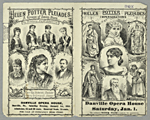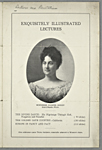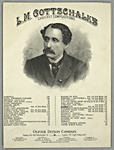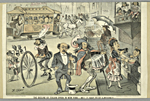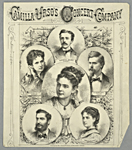Recitals and Recitations
"I have given eighty-five concerts in four months and a half. I have traveled fifteen thousand miles by train. At St. Louis I gave seven concerts in six days; at Chicago, five in four days. A few weeks more in this way and I would have become an idiot!" — Louis Moreau Gottschalk, diary entry for December 1862, quoted in Gottschalk, Notes of a Pianist, translated by Jeanne Behrend (1964)
During the 19th century, American audiences were drawn
to performances, such as recitals by musicians and vocalists, as
well as public programs, including readings and recitations by
well-known authors or speakers. From the 1840s on, instrumental
artists toured constantly by carriage, sea, and train. Their
routes differed to target specific audiences. Violinist Henri
Vieuxtemps and pianist Sigismund Thalberg toured together to the
larger cities on a route scheduled by Niblo's Gardens, their
sponsoring theater in New York. The Norwegian violinist Ole Bull
traveled to northern areas, where he was lauded by Scandinavian
settlers. The New Orleans-born Louis Moreau Gottschalk often
traveled over three loops -- New York to Chicago, New York south to
Havana, and New York south through Panama to California and back.
The importation of French, Italian, and, later, German opera (with
singers, dancers, and musicians) began on the Mississippi circuits
and continued through the century. These circuits, which included
Cuba, Santo Domingo, and Canada, focused on the European opera
house repertory, serving both the immigrant population and the
increasingly mobile North American audiences. The most famous
recital tour of the 19th century was the 1850-52 tour
of Swedish soprano Jenny Lind. Under the promotional direction of
P. T. Barnum, Lind sang arias and art songs from New York to San
Francisco and created a national sensation. The works of Gilbert
& Sullivan were presented across the country shortly after
their London premieres.
Almost every town had an active public education program,
featuring readings and recitations by authors, such as Mark Twain,
and political activists. National lecture bureaus provided
speakers to the local organizers, lyceum circuits, and Chatauquas.
Some speakers were so recognizable that other lecturers included
imitations of them in their own presentations. An evening program
generally included student reciters, vocal and piano performers,
and refreshments.
Refer to Map of the United
States and Mexico (1859), which
details explorers' trails, transportation routes,
settlement patterns, and locations of mineral wealth.
These factors greatly affected tours undertaken by
performing artists in America during the first half of
the 19th century.
